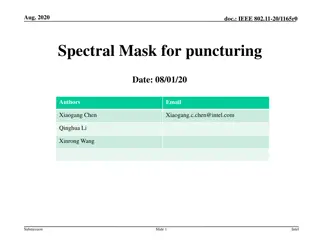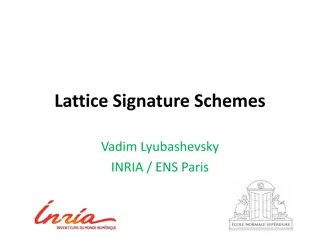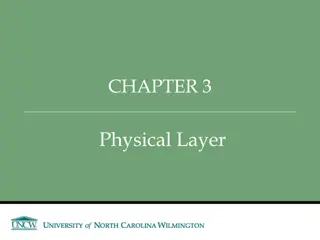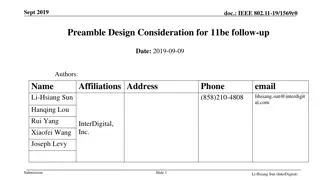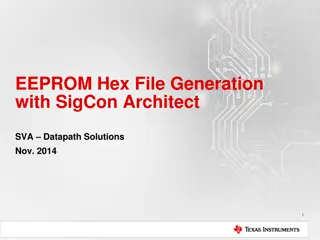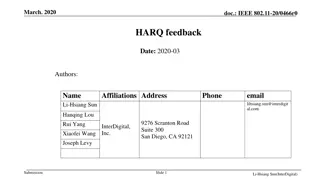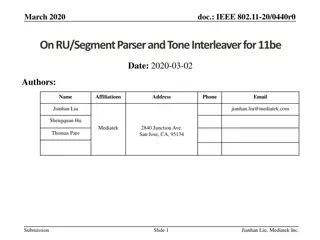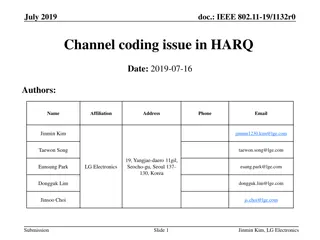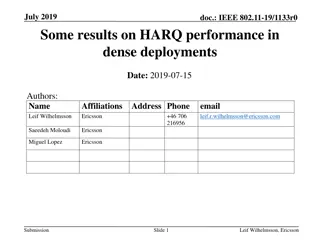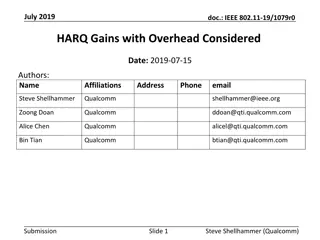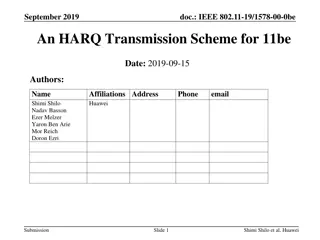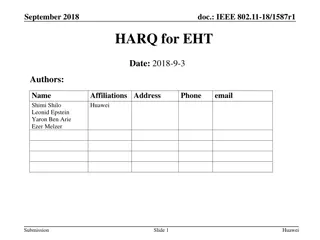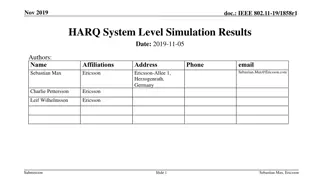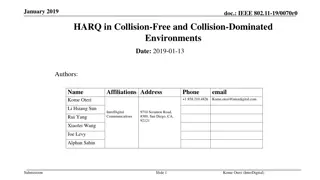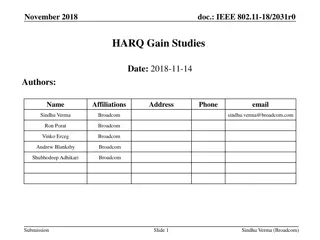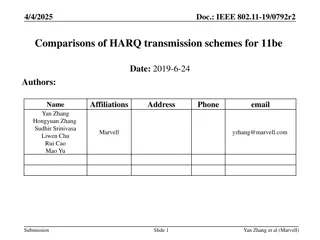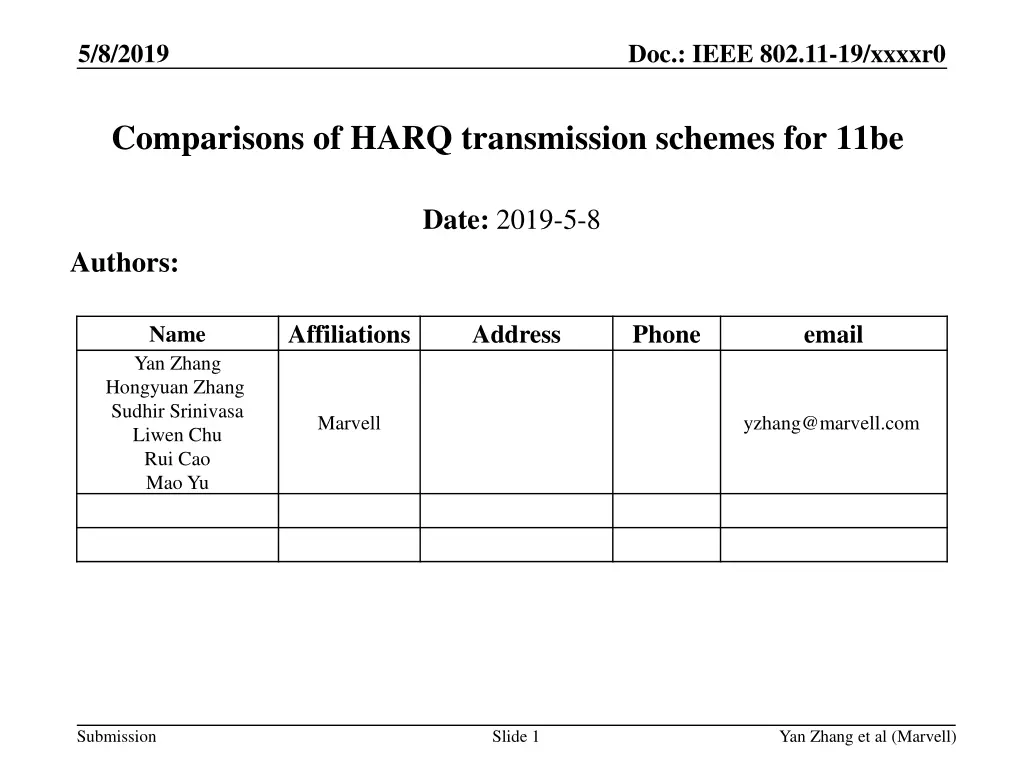
Comparing HARQ Transmission Schemes for IEEE 802.11be Standard
Explore the comparisons of various HARQ transmission schemes for the IEEE 802.11be standard. Delve into the benefits of HARQ Continuous Concatenation (CC), Improved Retransmission (IR) for LDPC encoding, and Punctured CC over traditional ARQ methods. Discover how frequency diversity and modified encoding schemes contribute to enhanced performance gains in wireless communication systems.
Download Presentation

Please find below an Image/Link to download the presentation.
The content on the website is provided AS IS for your information and personal use only. It may not be sold, licensed, or shared on other websites without obtaining consent from the author. If you encounter any issues during the download, it is possible that the publisher has removed the file from their server.
You are allowed to download the files provided on this website for personal or commercial use, subject to the condition that they are used lawfully. All files are the property of their respective owners.
The content on the website is provided AS IS for your information and personal use only. It may not be sold, licensed, or shared on other websites without obtaining consent from the author.
E N D
Presentation Transcript
5/8/2019 Doc.: IEEE 802.11-19/xxxxr0 Comparisons of HARQ transmission schemes for 11be Date: 2019-5-8 Authors: Affiliations Address Phone email Name Yan Zhang Hongyuan Zhang Sudhir Srinivasa Liwen Chu Rui Cao Mao Yu Marvell yzhang@marvell.com Submission Slide 1 Yan Zhang et al (Marvell)
6/1/2025 Doc.: IEEE 802.11-19/xxxxr0 HARQ Review HARQ CC is studied in [1][2][3], and show some performance gain over ARQ. To realize the gain, frequency diversity across transmissions is needed to achieve the potential gain via BCC interleaver or LDPC tone mapper patterns varying across transmissions. HARQ IR is shown to have larger performance gain over ARQ in [4][5]. However, this is done with BCC encoding, which is only applied to RU size less than or equal to 242 tones, and MCS up to 9. Hence the gain cannot be realized for the commonly used applications which utilize larger RU sizes and LDPC encoding. A modified HARQ CC scheme and HARQ IR for LDPC encoding scheme are explored and evaluated to show the potential gain of HARQ over ARQ. Submission Slide 2 Hongyuan Zhang et al (Marvell)
6/1/2025 Doc.: IEEE 802.11-19/xxxxr0 HARQ Punctured CC outline HARQ Punctured CC is improved upon regular HARQ CC to achieve higher throughput without adding much implementation complexities at both transmitter and receiver. All coded bits corresponding to an MPDU are transmitted in the first transmission as in regular HARQ CC. A portion of the coded bits are transmitted in the subsequent retransmissions for soft combining at receiver side. The percentage of the coded bits transmitted in the subsequent retransmissions can be determined based on the first transmission PER statistics. Submission Slide 3 Hongyuan Zhang et al (Marvell)
6/1/2025 Doc.: IEEE 802.11-19/xxxxr0 HARQ IR outline The HARQ IR for LDPC encoding scheme can support all LDPC code rates and all codeword lengths employed in current WIFI standards. Rate code designs still use the ones in current standard specs. All code rates higher than will be achieved by puncturing rate code for a given LDPC codeword length. The information bits and the parity bits which are not punctured are transmitted in the first transmission for a given MCS. Additional information and parity bits are transmitted in the subsequent retransmissions to achieve a lower effective code rate if the initial code rate is higher than 1/2.The lower effective code rates for the subsequent retransmissions can be determined based on either CQI reports or relevant PER statistics. For MCS values with rate code, use the same retransmission schemes as HARQ Punctured CC. Submission Slide 4 Yan Zhang et al (Marvell)
6/1/2025 Doc.: IEEE 802.11-19/xxxxr0 Simulation setup 20MHz 2x2 (2SS) and 80MHz 4x2 (2SS) DNLOS channel (channels are not normalized) 4x HE-LTF, MCS0-11 LDPC encoder Up to 4 (re)transmissions for each packet, same channel realization is applied across all (re)transmissions for each packet. With HARQ transmission, soft combining is done over all (re)transmissions. ARQ, HARQ CC, Punctured CC and IR are evaluated. Submission Slide 5 Yan Zhang et al (Marvell)
6/1/2025 Doc.: IEEE 802.11-19/xxxxr0 HARQ vs ARQ Throughput Comparison, with Optimal MCS selection ARQ vs HARQ goodput comparision, 20MHz, LDPC, 2x2, 2SS, Optimal MCS selection 200 180 160 140 Goodput (Mbps) 120 100 80 60 ARQ HARQ CC HARQ Punctured CC HARQ IR 40 20 0 5 10 15 20 25 30 35 40 45 SNR (dB) HARQ Punctured CC and IR achieves highest throughput due to the efficient retransmissions compared to HARQ CC and ARQ at the same SNR value. There is up to 7dB gain using HARQ Punctured CC or HARQ IR over ARQ, and up to 4dB gain using HARQ CC over ARQ even with optimal link adaptation for the same throughput. HARQ IR improves highest achievable throughput by 21% compared to ARQ. Submission Slide 6 Yan Zhang et al (Marvell)
6/1/2025 Doc.: IEEE 802.11-19/xxxxr0 HARQ Punctured CC vs ARQ with link adaptation Throughput Comparison, with first Tx PER varying 10-40% ARQ vs HARQ goodput comparision, 20MHz, LDPC, 2x2, 2SS 200 ARQ with rate drop in retx with first Tx PER 10% ARQ with rate drop in retx with first Tx PER 20% ARQ with rate drop in retx with first Tx PER 30% ARQ with rate drop in retx with first Tx PER 40% HARQ Punctured CC with first Tx PER 10% HARQ Punctured CC with first Tx PER 20% HARQ Punctured CC with first Tx PER 30% HARQ Punctured CC with first Tx PER 40% 180 160 140 120 Goodput (Mbps) 100 80 60 40 20 0 10 15 20 25 30 35 40 45 50 SNR (dB) HARQ Punctured CC throughput values do not vary much even though first Tx PER varies from 10% to 40%, i.e, SNR operating points varies about a few dBs. On the other hand, ARQ throughput values change significantly when first Tx PER varies from 10% to 40%, especially for MCS levels above MCS 6. HARQ Punctured CC still has throughput gain when operating at SNR points resulting in 40% first Tx PER over ARQ while ARQ is operating at SNR points resulting in 10% first Tx PER. See Appendix for detailed results of ARQ and HARQ schemes at each first Tx PER value. Submission Slide 7 Yan Zhang et al (Marvell)
6/1/2025 Doc.: IEEE 802.11-19/xxxxr0 HARQ IR vs ARQ with link adaptation Throughput Comparison, with first Tx PER around 10-40% ARQ vs HARQ goodput comparision, 20MHz, LDPC, 2x2, 2SS 250 ARQ with rate drop in retx with first Tx PER 10% ARQ with rate drop in retx with first Tx PER 20% ARQ with rate drop in retx with first Tx PER 30% ARQ with rate drop in retx with first Tx PER 40% HARQ IR with first Tx PER 10% HARQ IR with first Tx PER 20% HARQ IR with first Tx PER 30% HARQ IR with first Tx PER 40% 200 150 Goodput (Mbps) 100 50 0 10 15 20 25 30 35 40 45 50 SNR (dB) HARQ IR throughput values are almost the same even though first Tx PER varies from 10% to 40%. On the other hand, ARQ throughput values change significantly when first Tx PER varies from 10% to 40%, especially for MCS levels above MCS 6. HARQ IR still has throughput gain when operating at SNR points resulting in 40% first Tx PER over ARQ when ARQ is operating at SNR points resulting in 10% first Tx PER. Note that first Tx PERs of HARQ IR transmission for some MCS values are higher than those with ARQ transmission since the punctured LDPC codes are not optimized for code rates higher than . Submission Slide 8 Yan Zhang et al (Marvell)
6/1/2025 Doc.: IEEE 802.11-19/xxxxr0 HARQ vs ARQ Throughput Comparison, with Optimal MCS selection ARQ vs HARQ goodput comparision, 80MHz, LDPC, 4x2, 2SS, Optimal MCS selection 900 ARQ HARQ CC HARQ Punctured CC HARQ IR 800 700 600 Goodput (Mbps) 500 400 300 200 100 0 5 10 15 20 25 30 35 40 SNR (dB) HARQ IR and Punctured CC achieves highest throughput due to the efficient retransmissions compared to HARQ CC and ARQ at the same SNR value. There is up to 7dB gain using HARQ Punctured CC or IR over ARQ, up to 3dB gain over HARQ CC even with optimal link adaptation for the same throughput. HARQ IR improves highest achievable throughput by 11% compared to HARQ CC, and by 17% compared to ARQ. Submission Slide 9 Yan Zhang et al (Marvell)
6/1/2025 Doc.: IEEE 802.11-19/xxxxr0 HARQ Punctured CC vs ARQ with link adaptation Throughput Comparison, with first Tx PER around 10-40% ARQ vs HARQ goodput comparision, 80MHz, LDPC, 4x2, 2SS 800 ARQ with rate drop in retx with first Tx PER 10% ARQ with rate drop in retx with first Tx PER 20% ARQ with rate drop in retx with first Tx PER 30% ARQ with rate drop in retx with first Tx PER 40% HARQ Punctured CC with first Tx PER 10% HARQ Punctured CC with first Tx PER 20% HARQ Punctured CC with first Tx PER 30% HARQ Punctured CC with first Tx PER 40% 700 600 500 Goodput (Mbps) 400 300 200 100 0 5 10 15 20 SNR (dB) 25 30 35 HARQ Punctured CC throughput values do not vary much even though first Tx PER varies from 10% to 40%, i.e, SNR operating points varies about a few dBs. On the other hand, ARQ throughput values change significantly when first Tx PER varies from 10% to 40%, especially for MCS levels above MCS 6. See Appendix for detailed results of ARQ and HARQ schemes at each first Tx PER value. Submission Slide 10 Yan Zhang et al (Marvell)
6/1/2025 Doc.: IEEE 802.11-19/xxxxr0 HARQ IR vs ARQ with link adaptation Throughput Comparison, with first Tx PER around 10-40% ARQ vs HARQ goodput comparision, 80MHz, LDPC, 4x2, 2SS 800 ARQ with rate drop in retx with first Tx PER 10% ARQ with rate drop in retx with first Tx PER 20% ARQ with rate drop in retx with first Tx PER 30% ARQ with rate drop in retx with first Tx PER 40% HARQ IR with first Tx PER 10% HARQ IR with first Tx PER 20% HARQ IR with first Tx PER 30% HARQ IR with first Tx PER 40% 700 600 500 Goodput (Mbps) 400 300 200 100 0 5 10 15 20 25 30 35 SNR (dB) HARQ IR throughput values are almost the same even though first Tx PER varies from 10% to 40%, i.e, SNR operating points varies about a few dBs. On the other hand, ARQ throughput values change significantly when first Tx PER varies from 10% to 40%, especially for MCS levels above MCS 6. HARQ IR still has throughput gain when operating at SNR points resulting in 40% first Tx PER over ARQ when ARQ is operating at SNR points resulting in 10% first Tx PER. Submission Slide 11 Yan Zhang et al (Marvell)
6/1/2025 Doc.: IEEE 802.11-19/xxxxr0 Discussions and Conclusions As shown in slides 7-8, and 14-15, both HARQ Punctured CC and HARQ IR are very robust to the channel variations, i.e., the throughput values are hardly affected even though the variations of MCS assignments based on SNR measurements result in first Tx PER varying from 10% to 40%. On the other hand, ARQ throughput relies heavily on how good link adaptation can be, i.e., predicted MCS matches channel condition. ARQ throughput values varies significantly for a given MCS when SNR operating points varies within a few dBs range. Frequency diversity has to be applied to HARQ CC scheme with time varying LDPC tone mapper for each transmissions in order to achieve most of the gain, while it is not needed for HARQ Punctured CC and HARQ IR schemes. HARQ Punctured CC and HARQ IR outperforms HARQ CC if receiver buffer capacity can support soft combining up to 4 transmissions. HARQ IR has significant gain over HARQ CC and Punctured CC for MCS 10 and 11 by reducing effective code rate via retransmissions when first transmission PER is higher than 20%. Submission Slide 12 Yan Zhang et al (Marvell)
6/1/2025 Doc.: IEEE 802.11-19/xxxxr0 Reference [1] IEEE 802.11-18/1955r0 HARQ for EHT Further Information [2] IEEE 802.11-18/2029r1 HARQ in EHT [3] IEEE 802.11-18/1992r1 HARQ feasibility [4] IEEE 802.11-19/354r0 Consideration on HARQ [5] IEEE 802.11-19/390r0 Effect of Preamble Decoding on HARQ in 802.11be Submission Slide 13 Yan Zhang et al (Marvell)
6/1/2025 Doc.: IEEE 802.11-19/xxxxr0 Appendix 20MHz, 2x2, 2SS simulation results for different first Tx PERs 80MHz, 4x2, 2SS simulation results for different first Tx PERs Submission Slide 14 Yan Zhang et al (Marvell)
6/1/2025 Doc.: IEEE 802.11-19/xxxxr0 HARQ vs ARQ Throughput Comparison, with first Tx PER around 10% ARQ vs HARQ goodput comparision, 20MHz, LDPC, 2x2, 2SS, MCS selection with first Tx PER around0.1 200 180 160 140 Goodput (Mbps) 120 100 80 60 ARQ without rate drop in retx ARQ with rate drop HARQ CC HARQ Punctured CC HARQ IR 40 20 0 10 15 20 25 30 35 40 SNR (dB) If MCS is selected with first transmission PER around 10%, there is up to 6.5dB gain using HARQ Punctured CC or IR over ARQ without rate drop, and up to 5.5dB gain over ARQ with rate drop for the same throughput. *MCS 10 and 11 are not simulated since no SNR can achieve first Tx PER around 10%. *First Tx PER is greater than 10% for HARQ IR transmission since punctured LDPC codes are not optimized as regular LDPC codes. Submission Slide 15 Yan Zhang et al (Marvell)
6/1/2025 Doc.: IEEE 802.11-19/xxxxr0 HARQ vs ARQ Throughput Comparison, with first Tx PER around 20% ARQ vs HARQ goodput comparision, 20MHz, LDPC, 2x2, 2SS, MCS selection with first Tx PER around0.2 200 180 160 140 Goodput (Mbps) 120 100 80 60 ARQ without rate drop in retx ARQ with rate drop HARQ CC HARQ Punctured CC HARQ IR 40 20 0 10 15 20 25 30 35 40 45 50 SNR (dB) If MCS is selected with first transmission PER around 20%, there is up to 23dB gain using HARQ Punctured CC or IR over ARQ without rate drop and up to 18dB gain over ARQ with rate drop for the same throughput. Due to SNR sensitivity requirement for 1024AQM combined with high code rate, the throughput of MCS10 is even lower than that of MCS 9 using HARQ CC. On the other hand, HARQ IR MCS 10 still achieves higher throughput since it reduces effective code rate via retransmissions, resulting in lower SNR sensitivity requirement. HARQ IR improves highest achievable throughput by 77% compared to HARQ CC. *MCS11 is not simulated since no SNR can achieve first Tx PER around 20%. Submission Slide 16 Yan Zhang et al (Marvell)
6/1/2025 Doc.: IEEE 802.11-19/xxxxr0 HARQ vs ARQ Throughput Comparison, with first Tx PER around 30% ARQ vs HARQ goodput comparision, 20MHz, LDPC, 2x2, 2SS, MCS selection with first Tx PER around0.3 250 ARQ without rate drop in retx ARQ with rate drop HARQ CC HARQ Punctured CC HARQ IR 200 Goodput (Mbps) 150 100 50 0 10 15 20 25 30 35 40 45 SNR (dB) If MCS is selected with first transmission PER around 30%, there is up to 22dB gain using HARQ Punctured CC and IR over ARQ without rate drop, and up to 16dB gain over ARQ with rate drop for the same throughput. HARQ IR improves highest achievable throughput by almost 100% compared to HARQ CC. Submission Slide 17 Yan Zhang et al (Marvell)
6/1/2025 Doc.: IEEE 802.11-19/xxxxr0 HARQ vs ARQ Throughput Comparison, with first Tx PER around 40% ARQ vs HARQ goodput comparision, 20MHz, LDPC, 2x2, 2SS, MCS selection with first Tx PER around0.4 200 180 ARQ without rate drop in retx ARQ with rate drop HARQ CC HARQ Punctured CC HARQ IR 160 140 Goodput (Mbps) 120 100 80 60 40 20 0 10 15 20 25 SNR (dB) 30 35 40 45 If MCS is selected with first transmission PER around 40%, there is up to 23dB gain using HARQ Punctured CC or IR over ARQ without rate drop, and up to 17dB gain over ARQ with rate drop for the same throughput. HARQ IR improves highest achievable throughput by almost 100% compared to HARQ CC. Submission Slide 18 Yan Zhang et al (Marvell)
6/1/2025 Doc.: IEEE 802.11-19/xxxxr0 HARQ vs ARQ Throughput Comparison, with first Tx PER around 10% ARQ vs HARQ goodput comparision, 80MHz, LDPC, 4x2, 2SS, MCS selection with first Tx PER around0.1 800 700 600 500 Goodput (Mbps) 400 300 ARQ without rate drop in retx ARQ with rate drop HARQ CC HARQ Punctured CC HARQ IR 200 100 0 5 10 15 20 25 30 SNR (dB) If MCS is selected with first transmission PER around 10%, there is up to 6-7dB gain using HARQ punctured CC or IR over ARQ without rate drop, and up to 4.5-5.5dB gain over ARQ with rate drop for the same throughput. HARQ IR has slight loss at MCS levels lower than 9, and slight gain at MCS 9 compared to HARQ Punctured CC. HARQ punctured CC or HARQ IR improves highest achievable throughput by 11% compared to HARQ CC, and by 27% compared to ARQ. *MCS 10 and 11 are not simulated since no SNR can achieve first Tx PER around 10%. *First Tx PER is greater than 10% for HARQ IR transmission since punctured LDPC codes are not optimized as regular LDPC codes. Submission Slide 19 Yan Zhang et al (Marvell)
6/1/2025 Doc.: IEEE 802.11-19/xxxxr0 HARQ vs ARQ Throughput Comparison, with first Tx PER around 20% ARQ vs HARQ goodput comparision, 80MHz, LDPC, 4x2, 2SS, MCS selection with first Tx PER around0.2 800 ARQ without rate drop in retx ARQ with rate drop HARQ CC HARQ Punctured CC HARQ IR 700 600 500 Goodput (Mbps) 400 300 200 100 0 5 10 15 20 25 30 SNR (dB) If MCS is selected with first transmission PER around 20%, there is up to 9-9.5dB gain using HARQ Punctured CC or HARQ IR over ARQ without rate drop, and up to 7-7.5dB gain over ARQ with rate drop for the same throughput. HARQ punctured CC or HARQ IR improves highest achievable throughput by 17% compared to HARQ CC, and by 40% compared to ARQ with rate drop. *MCS10 and 11 are not simulated since no SNR can achieve first Tx PER around 20%. Submission Slide 20 Yan Zhang et al (Marvell)
6/1/2025 Doc.: IEEE 802.11-19/xxxxr0 HARQ vs ARQ Throughput Comparison, with first Tx PER around 30% ARQ vs HARQ goodput comparision, 80MHz, LDPC, 4x2, 2SS, MCS selection with first Tx PER around0.3 900 800 700 600 Goodput (Mbps) 500 400 300 ARQ without rate drop in retx ARQ with rate drop HARQ CC HARQ Punctured CC HARQ IR 200 100 0 5 10 15 20 25 30 35 40 SNR (dB) If MCS is selected with first transmission PER around 30%, there is up to 22dB gain using HARQ Punctured CC or IR over ARQ without rate drop, and up to 14.5dB gain over ARQ with rate drop for the same throughput. HARQ IR improves highest achievable throughput by 90% compared to ARQ with rate drop, more than 65% compared to HARQ CC, and more than 20% compared to HARQ IR. Submission Slide 21 Yan Zhang et al (Marvell)
6/1/2025 Doc.: IEEE 802.11-19/xxxxr0 HARQ vs ARQ Throughput Comparison, with first Tx PER around 40% ARQ vs HARQ goodput comparision, 80MHz, LDPC, 4x2, 2SS, MCS selection with first Tx PER around0.4 800 ARQ without rate drop in retx ARQ with rate drop HARQ CC HARQ Punctured CC HARQ IR 700 600 500 Goodput (Mbps) 400 300 200 100 0 5 10 15 20 25 30 35 SNR (dB) If MCS is selected with first transmission PER around 40%, there is up to 20dB gain using HARQ Punctured CC or IR over ARQ without rate drop, and up to 13dB gain over ARQ with rate drop for the same throughput. HARQ IR improves highest achievable throughput by 100% compared to ARQ with rate drop, more than 60% compared to HARQ CC, and more than 24% compared to HARQ Punctured CC. Submission Slide 22 Yan Zhang et al (Marvell)

